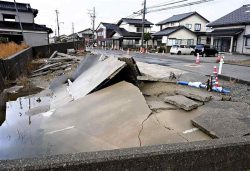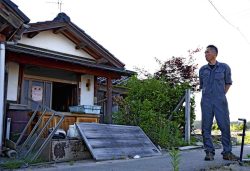Noto Quake — A Closer Look / 1,000s of Homes Still Without Running Water After Quake; Prior Tremors Had Taken a Cumulative Toll on Aging Pipes

Water pipe repair work is underway Tuesday in Wajima, Ishikawa Prefecture.
20:00 JST, February 3, 2024
One month has passed since the deadly Jan. 1 Noto Peninsula Earthquake. This is the third installment of a series examining issues that have emerged in the disaster-stricken areas.
***
Nearly all of the approximately 10,000 households in Wajima, Ishikawa Prefecture, have been without running water since the Noto Peninsula Earthquake. An 83-year-old woman in the city’s Monzenmachi district, which is pressed between the mountains and the sea, puts two 10-liter plastic tanks in a wheelbarrow and goes to get spring water near her home several times a day. Running water has been cut off in the district since the Jan. 1 earthquake.
The woman suffered burns to her leg when hot water spilled on her due to the tremors of the earthquake. She cannot rely on her husband, 87, because his weak eyesight makes it difficult for him to walk outside. By herself, she can only manage to carry water for cooking and laundry, so they have been unable to bathe.
“I wonder how long this will continue,” she said in an exhausted tone.
In Wajima, small villages are dispersed in the mountains and the total length of water pipes extends to about 600 kilometers. Many parts of the underground water pipes are damaged. An official at the Wajima municipal government bitterly said, “There are more than 200 places that need to be repaired.”
Even if they try to lay new pipes, rocks shifted by the earthquake get in the way. It is only possible to fix several meters of water pipes on some days, according to the government.
The quake cut off running water to about 55,000 households in six municipalities in the Noto Peninsula. Even a month after the earthquake, about 40,000 households still had no running water. Water service has been restored for only 30% of them.
In the 2016 Kumamoto Earthquake, up to 450,000 households did not have running water, but service was largely restored about one month later. The Ishikawa prefectural government aims to carry out at least temporary measures to restore water supply by the end of March, but progress has been conspicuously slow.
“The water pipes are severely damaged. The disaster shed fresh light on the vulnerability of the infrastructure of the Noto region,” Ishikawa Gov. Hiroshi Hase said.
In Shika, just 10.4% of the water pipes had been deemed earthquake-resistant. In Nanao, it was 21.6%. In six heavily damaged municipalities, the figure was below the national average of 41.2%. Moreover, a series of earthquakes that have occurred in the Noto Peninsula since December 2020 have caused cumulative damage to the water pipes.
To maintain infrastructure in increasingly depopulated areas, fees need to be raised. In the mountainous terrain of the Noto Peninsula, it costs a lot to build pump stations to move water to higher levels. The average household water bill in the four municipalities at the northern end of the peninsula, including Wajima and Suzu, is ¥4,000 to ¥5,500 a month, about twice as expensive as in Kanazawa, Ishikawa Prefecture’s capital.
Infrastructure is rapidly aging across Japan, posing risks when a disaster occurs. Much of today’s infrastructure was built during the high growth period in the 1960s and 1970s. The expected lifespan of most infrastructure is said to be about 50 years. By 2040, 75% of bridges, 66% of ports and 53% of tunnels will have reached that age.
New efforts are underway to address the situation. The Noto Peninsula Earthquake marks the first time for the Land, Infrastructure, Transport and Tourism Ministry to send officials to help restore water and sewerage facilities. They contacted other officials of the ministry, who were in charge of road development and maintenance, to ensure smooth operations. The water supply administration, which has been under the jurisdiction of the Health, Labor and Welfare Ministry, will be transferred in April to the infrastructure ministry, which has jurisdiction over sewerage systems.
In its sewerage system management, the ministry has inspected the deterioration of sewer pipes and pumps using sensors equipped with artificial intelligence for greater efficiency of inspection and repair. According to the ministry’s Water and Disaster Management Bureau, integrated management of the water supply and sewerage systems will further increase efficiency.
Yuji Nemoto, a professor of public policy at Toyo University, said: “As infrastructure is aging, there will be greater damage from earthquakes. It is necessary to repair and inspect infrastructure facilities in normal times in order of priority. Regional municipalities with small populations must consider the issue seriously.”
"Society" POPULAR ARTICLE
-

M4.9 Earthquake Hits Tokyo, Neighboring Prefectures
-

M7.5 Earthquake Hits Northern Japan; Tsunami Waves Observed in Hokkaido, Aomori and Iwate Prefectures
-

Tsukiji Market Urges Tourists to Avoid Visiting in Year-End
-

Israeli Tourists Refused Accommodation at Hotel in Japan’s Nagano Pref., Prompting Protest by Israeli Embassy and Probe by Prefecture
-

M5.7 Earthquake Hits Japan’s Kumamoto Pref., Measuring Upper 5 Intensity, No Tsunami Expected
JN ACCESS RANKING
-

Keidanren Chairman Yoshinobu Tsutsui Visits Kashiwazaki-Kariwa Nuclear Power Plant; Inspects New Emergency Safety System
-

Imports of Rare Earths from China Facing Delays, May Be Caused by Deterioration of Japan-China Relations
-

University of Tokyo Professor Discusses Japanese Economic Security in Interview Ahead of Forum
-

Japan Pulls out of Vietnam Nuclear Project, Complicating Hanoi’s Power Plans
-

Govt Aims to Expand NISA Program Lineup, Abolish Age Restriction
























